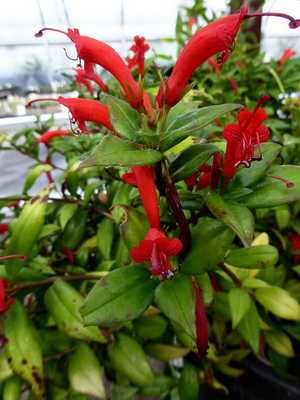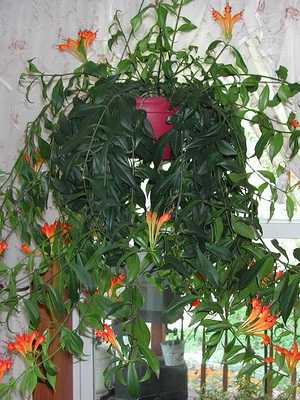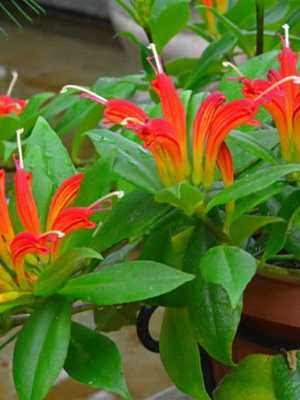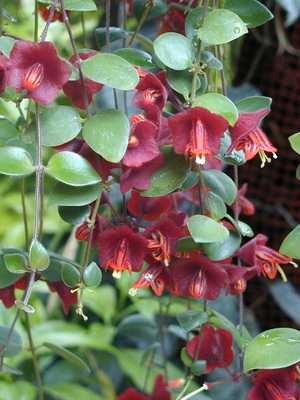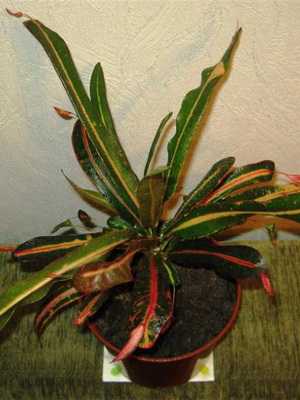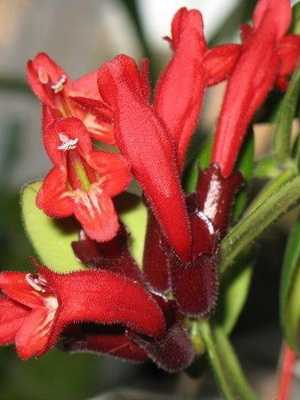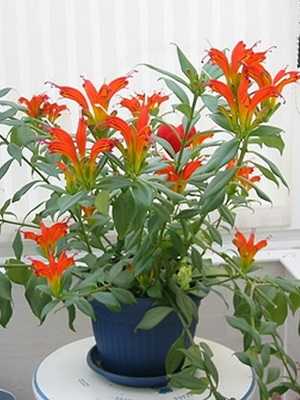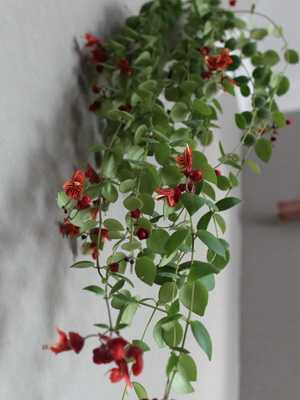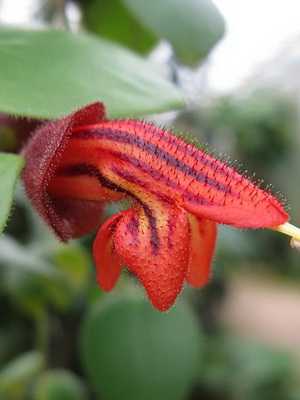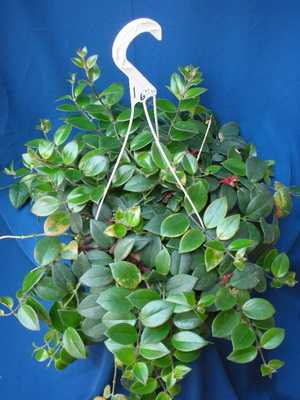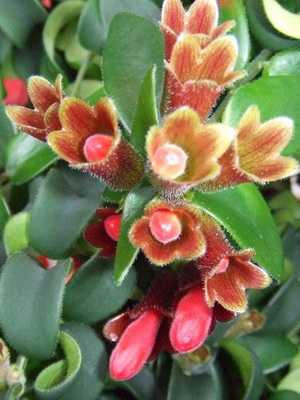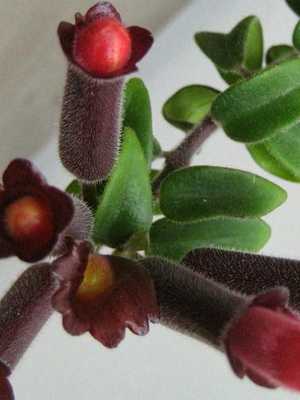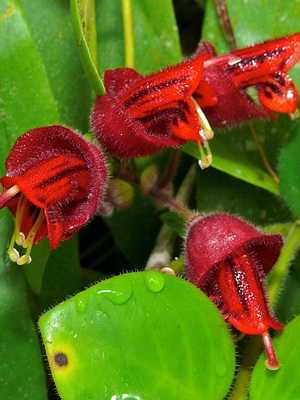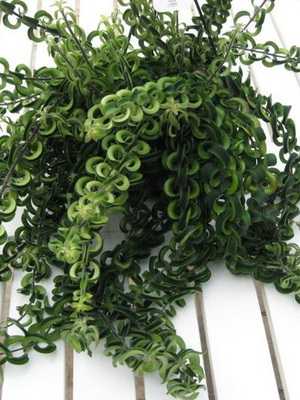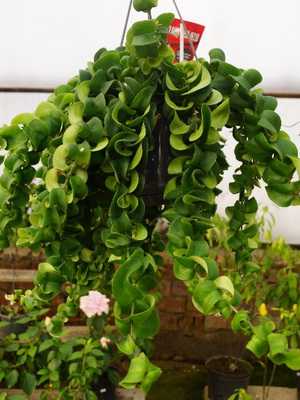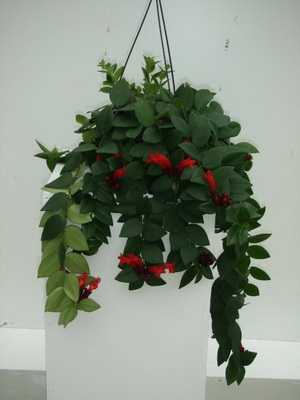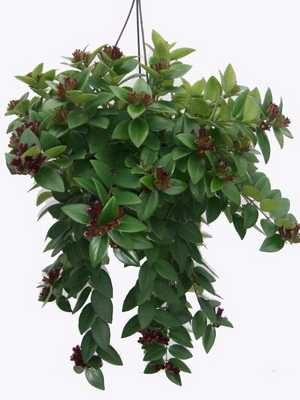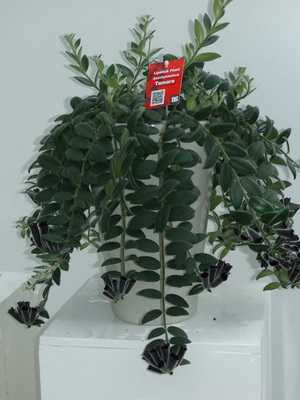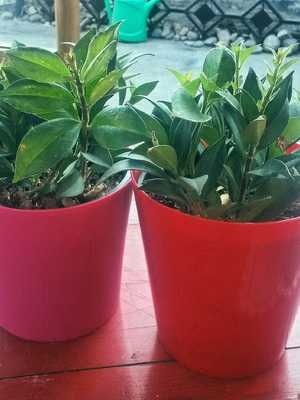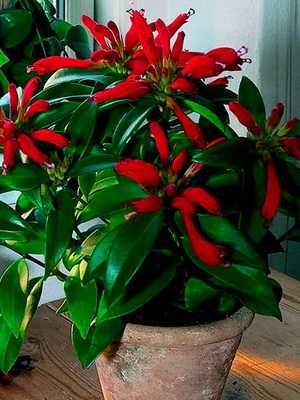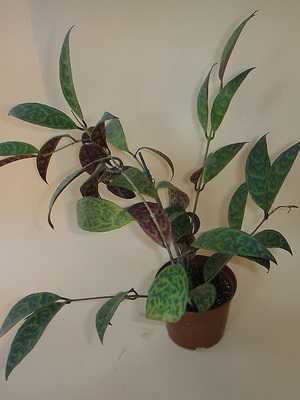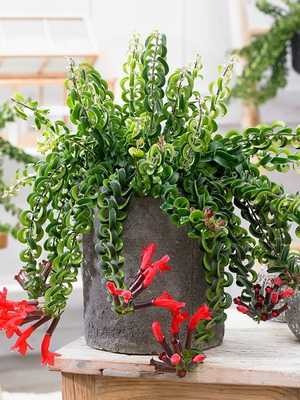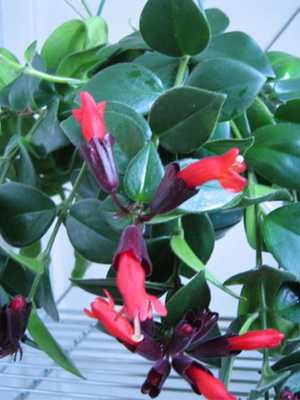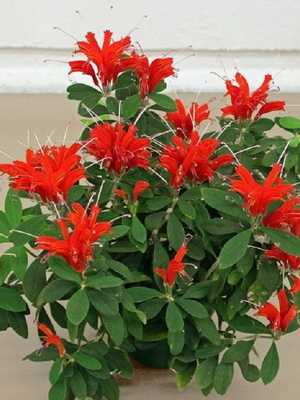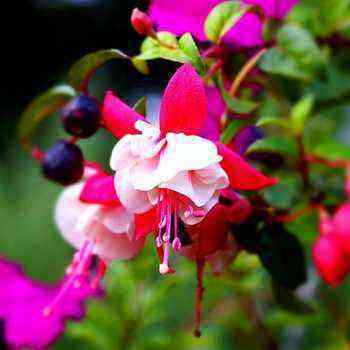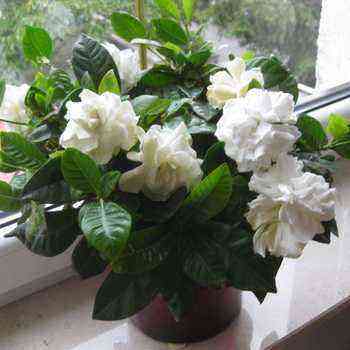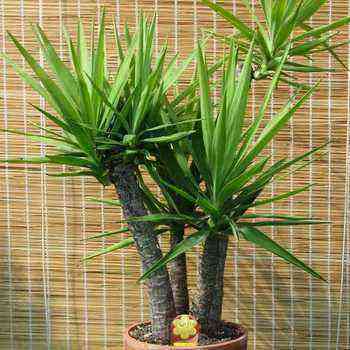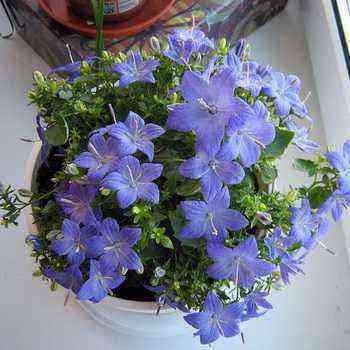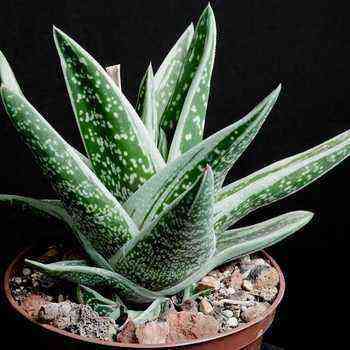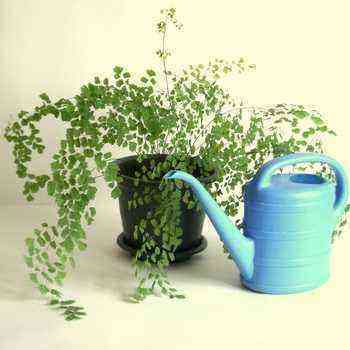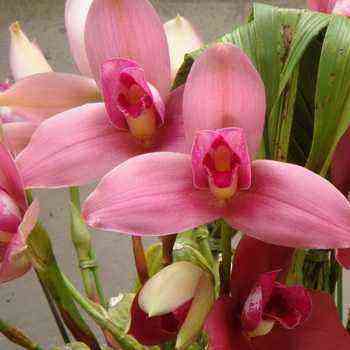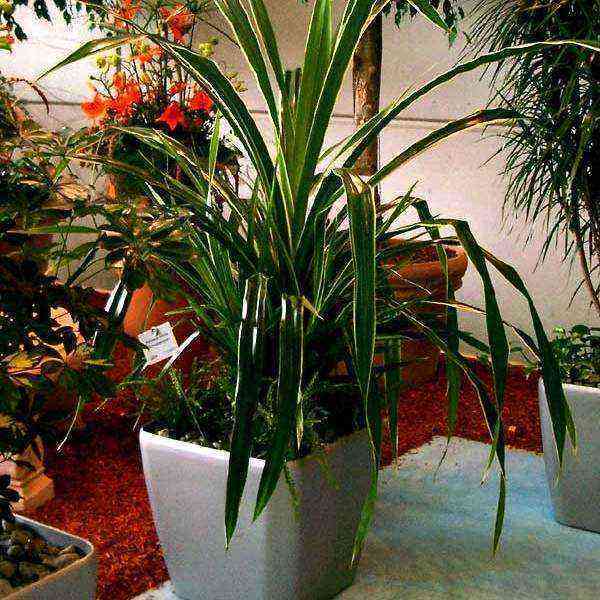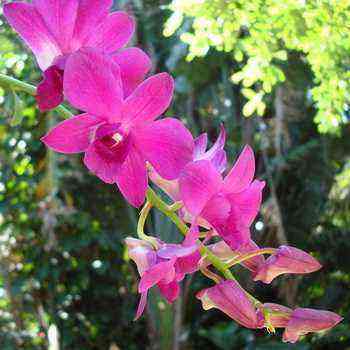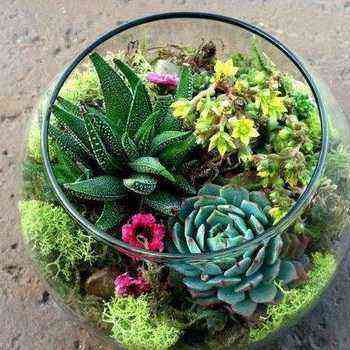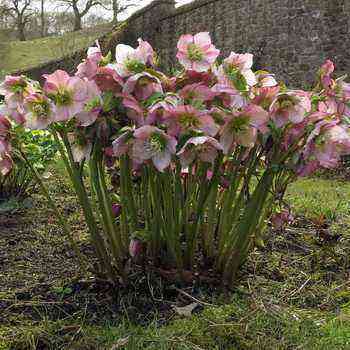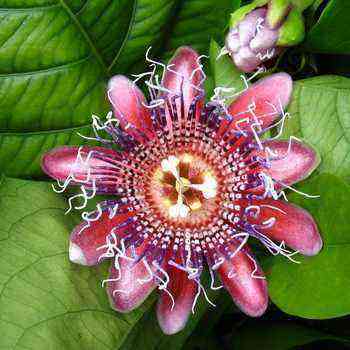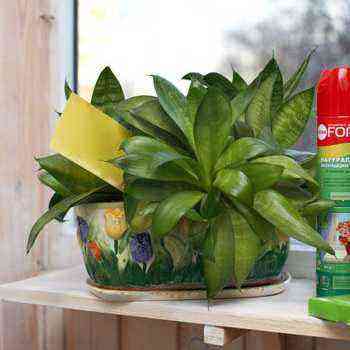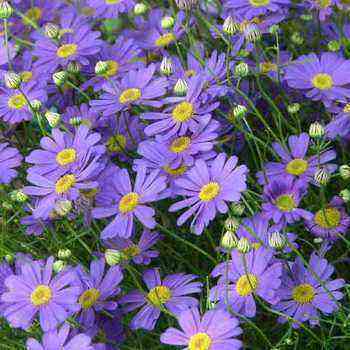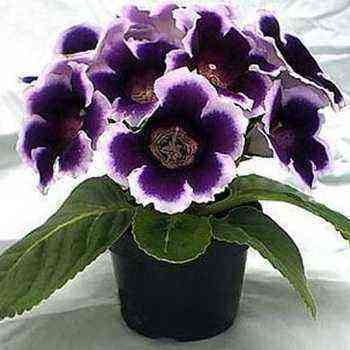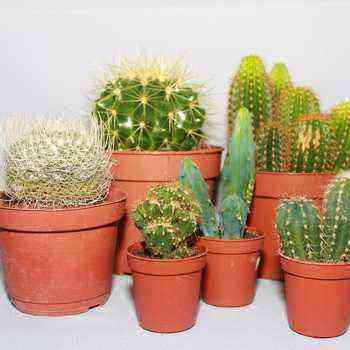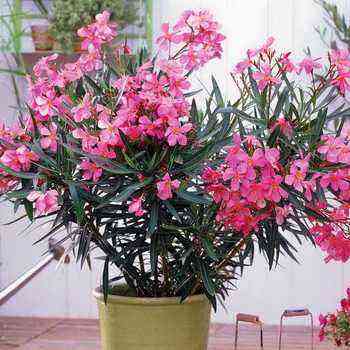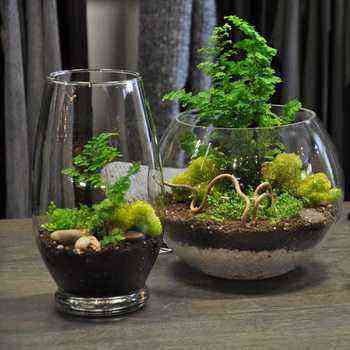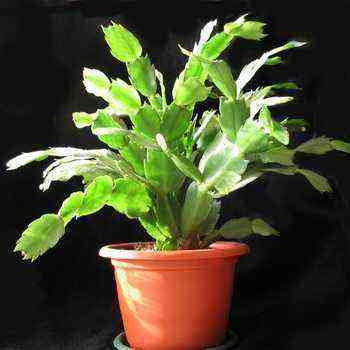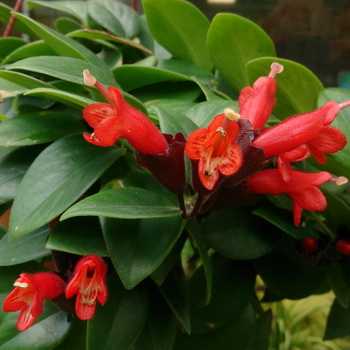
Description of the indoor flower eschinanthus and photos during the flowering period
Indoor, cultivated flower eschinanthus belongs to the perennial representatives of the Gesneriaceae family. It grows in nature on trees, wrapping around their crown, but at the same time it receives nutrients from the external environment, the soil. Less common are species that are half epiphytic shrubs. Homeland – tropical Asia. Usually this genus of the Gesnerievs grows near water bodies, waterfalls, where it is quite humid.
Take a look, below are a photo depicting an indoor flower Aeschinanthus and growing in natural conditions:
It is an ornamental deciduous and flowering perennial evergreen herb with long, downward-flowing shoots, leathery oval thick patterned leaves and bright red, green-yellow and red-brown flowers. The length of its stems can reach 0,9 m. Due to the downward-growing shoots, the plant looks great in hanging pots. Its leaves grow up to 1 dm, are located opposite each other, connected to the stem by a small cuttings.
Aeschinanthus bloom lasts a fairly long period. It blooms in the summer with apical or axillary inflorescences. The flowers of the plant are described as elongated, slightly multi-colored tubes with a double-lipped bend. They can grow 1 or several buds. Not yet blossoming, the latter resemble a tube of lipstick, for which (and also for the bright appearance of the petals) the locals called the plant a “fondant flower”. A whitish bract is visible from the center of such a “tube”.
Popular types and varieties of the houseplant eschinanthus (with photo)
According to The Plant List from 2013, there were 194 species of Aeschinanthus growing in nature. The beauty of the evergreen epiphyte gave rise to a desire among gardeners to get other colors of its buds. Therefore, using the method of crossing natural species and bred varieties of Aeschinanthus, breeders have achieved a variety of colors of its flowers.
The most popular varieties are:
E. marbled (A. marmoratus).
E. striped (A. vittatus).
E. beautiful (A. speciosus).
E. tricolor (A. tricolor).
E. hybrid (A. hybridus).
Look, below are photos of some of the varieties and species of Aeschinanthus that exist today:
Aeschinanthus marble can rather be attributed to evergreens, because tubular buds of a pale emerald color with brown blotches on it appear quite rarely. The species got its name for the marble, rich emerald with sunny greenish veins, and below – burgundy foliage, located on flexible long stems.
Aeschinanthus beautiful is the type of aeschinanthus plant that you can often find in home collections. Fleshy dark emerald foliage departs from its curving long (up to 0,6 m) shoots on small cuttings. Leaves can be up to 1 dm. His scarlet flowers are collected in inflorescences of 12 buds.
The tricolor species is distinguished by medium-sized green foliage, a flower with a wide calyx of pinkish or reddish color. The scarlet corolla has dark and orange streaks.
All cultivars of the plant Aeschinanthus artificially bred by means of selection are collected under a single name “Hybrid Eschinantus”.
Among them:
Twister.
Bella Donna.
“Tamara”.
In the first of them, the foliage and shoots grow in twisting, spiral-like, and scarlet buds appear from the axils of the leaves. The second has dense scarlet flowers and glossy, slightly rounded foliage. The latter is distinguished by fluffy leaves and flowers, covered with numerous silvery processes, giving the plant a characteristic shade.
Here are some tips for growing this plant.
How to care for an eschinanthus flower: growing conditions
There are several features of growing an eschinantus house. It is necessary to strive to create growth conditions for it, as much as possible corresponding to the natural environment. This is a shade-tolerant plant that does not tolerate direct sun. At the same time, a lack of lighting can lead to a lack of flowers on the shoots. It will grow best in the east or west of the room. If the windows face north, most likely, the owners will not wait for flowering. When the windows are oriented to the south and in the heat, you need to organize a shadow.
When studying how to care for an escinanthus flower, you should pay attention to the temperature regime of its cultivation. In winter, during the dormant period, when flower buds are formed, the optimum temperature is 18–20 ° C, in summer 22–25 ° C. The plant loves warmth, but with a little temperature stress, it will bloom faster. It is very important to remember that a strong decrease in temperature can lead to complete shedding of foliage. Epiphyte does not tolerate drafts and sudden temperature changes, which can result in the death of a pet.
When planting a home flower called eschinanthus, it must be remembered that wild representatives of the Gesneriev family grow near water, where the air is well humidified.
Therefore, he needs high humidity, for which:
- In summer, the plant is regularly sprayed with settled warm water.
- In winter, they put a flowerpot in a pallet with moistened expanded clay; leaves are not irrigated.
Moisture is especially needed during flowering. You should also ensure good ventilation of the room.
Watering the land and replanting the eschinanthus in a new pot
Caring for the eschinanthus flower suggests that abundant watering should be carried out during the growth period (April – September). At the same time, water is used soft, settled, not cold. In winter, after dropping the leaves (in deciduous species), watering is stopped; in evergreens, a moist earthen lump is maintained. An excess of moisture during watering is detrimental to the plant, which causes the roots to rot.
Complete mineral fertilization is applied every two weeks from April to September. In autumn, after the leaves have fallen off, very long and stiff shoots are cut by 15-20 cm. Such pruning provokes the appearance of new young stems, leading to the splendor of the flower.
The process of transplanting an adult Aeschinanthus is carried out for several reasons:
- If the plant is just purchased.
- If necessary, renew the soil.
- When the flower is sick.
Before proceeding with the manipulations, you need to wait a few days to see if the new pet is infected with pests after buying a flower. In the spring, as soon as the buds swell, the plant is transplanted. This happens by the transshipment method.
The pot for transplanting the eschinanthus needs to be taken low and wide, but only a couple of centimeters larger than the previous one, because the plant develops better in cramped conditions. To create a lush bush, several plants are planted in one pot. At the bottom of the flowerpot, it is necessary to place expanded clay drainage with a height of about 3 cm. It is not necessary to remove the previous ball of the substrate from the roots, so as not to damage the root system. It is necessary to move the contents of the previous pot on top of the drainage, sprinkling it on all sides with soil for stability.
Aeschinanthus soil will need a well-aerated, loosened, nutrient-rich soil. Its acidity should be in the range of pH 5,0 – 7,0.
The substrate for planting and transplanting can be made by yourself, for which you will need in shares:
- Leafy and compost soil, peat, sand (4: 2: 1: 1).
- Land of leaves (2), peat (1), humus (1), sand (1).
To create more aeration, you can enrich the ground with sphagnum moss, charcoal, pine bark. If preference is given to purchased soil, it is worth opting for a substrate for saintpaulias or orchids.
Planting and breeding methods of aeschinanthus
Having delighted its owners for 5 years, Aeschinanthus needs to plant a new sprout. This is due to the fact that a representative of the Gesneriev family has evergreen foliage and long shoots, which grow quite actively in the spring. Located closer to the ground, its stems become stiffer over the years, the greenery falls on them. Because of this, the plant loses its attractive appearance, splendor. In this case, it makes sense to replace the old flower with a new one. In order not to acquire a new pet in the store, it is worth multiplying it in advance.
Reproduction of eschinanthus is possible even at home.
There are 3 ways to do this:
- Seeds.
- Cuttings.
- Leaves.
Reproduction by semen is rather complicated; it is more often used in laboratory conditions. But some amateur gardeners still try to plant the plant this way. To do this, sprinkle the seed evenly on even wet soil in the container and cover with glass. It is watered from below, liquid and nutrients come from the pan. The temperature regime of the room where the seed is trying to sprout should be over + 25 ° C. When the first shoots appear, the glass is removed. These seedlings are planted in a flowerpot in several pieces. New plants bloom in a year.
How to root aeschinanthus when propagating by cuttings and leaves
Aeschinanthus propagation, carried out by cuttings, occurs through the rooting of the end of the stem about 1 dm long. It is imperative that the length of the seedling covers at least 3 developed internodes. After the cutting is cut, its lower part is treated with a preparation for early rooting, planted in a container with earth (preferably transparent plastic). In this case, the substrate should consist of a sand-peat mixture (taken in equal proportions). Before planting, it is best to process the soil at high temperatures (in the oven or with boiling water, then dry it) – this will help protect it from pests.
When studying how you can root aeschinanthus, you should pay attention to the fact that the temperature regime should be constant, + 25 ° C during the entire period of root regrowth (this takes about 2 – 3 weeks). Cut cuttings are rooted in a humid environment. Before the first roots appear, they should be closed with a bag or glass container, as if creating a greenhouse. After rooting, the cover is periodically removed for a while, making it possible for the seedling to get used to the environment. When the stalk grows up, it must be transplanted into a large container. Such manipulations can be carried out in the spring and summer months.
In order to reproduce the eschinanthus not with a handle, but with a leaf, you need to cut off the latter with a bud from the stem. The cut site should be treated with a rooting agent, placed in a container with a substrate. Arrange a greenhouse, as described above, maintaining a temperature regime of more than + 25 ° C. It will take about a month for the roots to appear. After that, you can transplant the plant into a large container.
Why Eschinanthus does not bloom and leaves fall: diseases and pests
It is important to know what diseases and pests are terrible for Aeschinanthus:
- The defeat of a spider mite with dry room air.
- The appearance of gray mold (mildew-like) in excessively damp, cool rooms.
- The emergence of thrips, aphids, mealybugs.
- The appearance of a brownish spot on foliage due to improper water temperature during watering (+ 23 ° C is needed).
- Spotting on the buds, their shedding when liquid gets on them during watering.
Due to the appearance of small cobwebs and insects on the foliage, the leaves dry out and fall off. The fight against such a pest consists in treatment with soapy water or insecticides. Falling greenery is also possible due to the extremely low room temperature in the cold season or too dry soil in the summer months.
To get rid of gray rot, the flower should be treated with the “Fundazol” solution, less often watering. If light blotches, thrips, or other pests have appeared on the foliage, it is necessary to treat the plant with diluted preparations “Fitoverma” or “Aktelika”.
Asking the question why the eschinanthus does not bloom, you should pay attention to the fact that for the appearance of buds, the plant needs sufficient illumination, as well as a specific temperature regime with small differences. During winter dormancy, when flower buds are born, the room should not be less than + 16 ° C.
If the indoor air is too dry and hot, the leaves of the plant begin to turn yellow and dry out at the edges. To eliminate this problem, you need to spray greens, install a flowerpot in a pallet with wet drainage.
After viewing this material, possible questions about growing a flower will disappear.
Let the pet bloom and please the owners for a long time!
